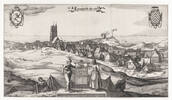(Fe)male Voices on Stage
Finding Patterns in Lottery Rhymes of the Late Medieval and Early Modern Low Countries with and without AI
DOI:
https://doi.org/10.51769/bmgn-lchr.13872Abstract
Dit artikel onderzoekt de patronen in loterijrijmpjes uit de laatmiddeleeuwse en vroegmoderne Lage Landen, met een focus op de rijmpjes geschreven door vrouwen. Loterijen waren een populaire methode om geld op te halen, en de loterijrijmpjes, persoonlijke boodschappen die werden neergeschreven op de loten, zijn een waardevolle bron voor historici. We verzamelden meer dan 11,000 gedigitaliseerde korte teksten afkomstig van vijf loterijen die plaatsvonden tussen 1446 en 1606. In de analyse maakten we gebruik van GysBERT, een taalmodel voor historisch Nederlands, om kenmerkende discoursen voor mannelijke en vrouwelijke auteurs te identificeren. Hoewel GysBERTs resultaten ons op het spoor brachten van enkele interessante patronen, lieten ze ook zien dat de rijmpjes geschreven door mannen en vrouwen niet radicaal van elkaar verschillen. Dit is in lijn met inzichten uit de historiografie over vroegmoderne vrouwen, waarin wordt benadrukt dat vrouwen functioneerden binnen maatschappelijke, en in dit geval ook literaire, conventies. Soms werden deze conventies door vrouwen ondermijnd, soms aangepast, maar soms ook zonder verandering overgenomen.
This article explores the patterns in lottery rhymes produced in the late medieval and early modern Low Countries, with a focus on the rhymes written by women. The lottery was a popular fundraising event in the Low Countries. Lottery rhymes, personal messages attached to the lottery tickets, provide a valuable source for historians. We collected more than 11,000 digitised short texts from five lotteries held between 1446 and 1606. We have used GysBERT, a language model of historical Dutch, to identify distinctively male and female discourses in the lottery rhymes corpus. Although the model pointed us to some interesting patterns, it also showed that lottery rhymes written by men and women do not radically differ from each other. This is consistent with insights from premodern women’s history which stresses that women worked within societal, and in this case literary, conventions, sometimes subverting them, sometimes adapting them, sometimes adopting them unchanged.
Downloads

Published
Issue
Section
License
Copyright (c) 2024 Marly Terwisscha van Scheltinga, Sara Budts, Jeroen Puttevils

This work is licensed under a Creative Commons Attribution 4.0 International License.
Authors who publish with this journal agree to the following terms:
a) Authors retain copyright and grant the journal right of first publication with the work simultaneously licensed under a Creative Commons Attribution 4.0 International (CC BY 4.0) that allows others to share the work with an acknowledgement of the work's authorship and initial publication in this journal.
b) Authors are able to enter into separate, additional contractual arrangements for the non-exclusive distribution of the journal's published version of the work (e.g., post it to an institutional repository or publish it in a book), with an acknowledgement of its initial publication in this journal.
c) Authors are permitted to post their work online (e.g., in institutional repositories or on their website) prior to and during the submission process.
Authors are explicitly encouraged to deposit their published article in their institutional repository.
How to Cite
Funding data
-
Fonds Wetenschappelijk Onderzoek
Grant numbers 11I1922N







